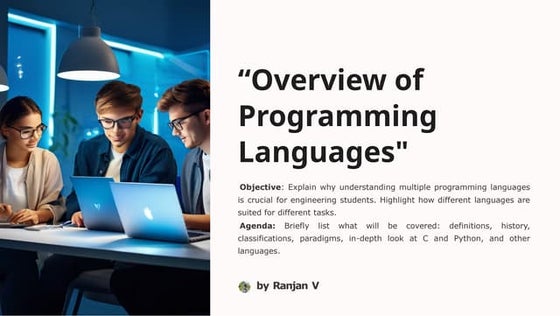Introduction-to-Computer-Languages.pptxx
Download as PPTX, PDF0 likes6 views
introduction to computer languages
1 of 9
Download to read offline

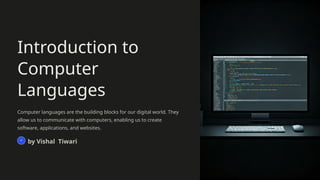
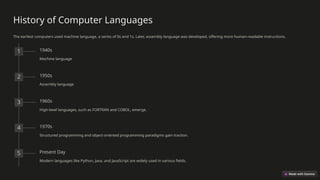
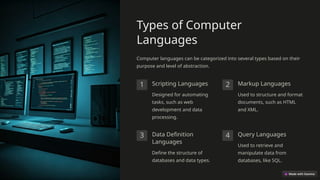
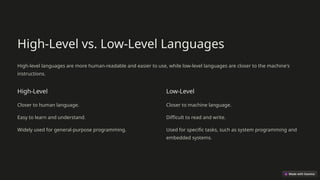
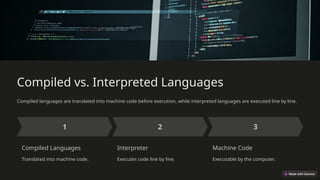
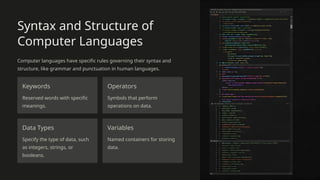

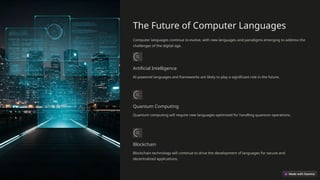
Recommended
Intro to programming and intro to java netbean.pdf



Intro to programming and intro to java netbean.pdfErwinButchNicolas1
?
Intro to programming with java application.Programming languages in bioinformatics by dr. jayarama reddy



Programming languages in bioinformatics by dr. jayarama reddyDr. Jayarama Reddy
?
A programming language is a formal language comprising a set of instructions that produce various kinds of output. Programming languages are used in computer programming to implement algorithms. Most programming languages consist of instructions for computers.CSC103 Intro to Programming



CSC103 Intro to ProgrammingRichard Homa
?
PowerPoint Presentation that introduces the Programming Unit with some basic overview, terms, history before working with the Python programming language.A Short Communication On Computer Programming Languages In Modern Era



A Short Communication On Computer Programming Languages In Modern EraKatie Naple
?
This document provides an overview of computer programming languages throughout history. It discusses how programming languages have evolved from machine languages to modern high-level languages. Key points include:
1) Programming languages have developed from low-level machine languages and assembly languages to modern high-level languages to simplify programming and communication between humans and computers.
2) Popular modern languages include C++, Java, Python, and JavaScript, which are often used to build web applications.
3) Programming languages continue to be developed to meet new needs, such as languages for scientific computing, business applications, education, and more specialized domains.Programing 



Programing Ahmed Alkoudah
?
A programming language is a formal language used to communicate instructions to a computer. Programming languages allow programmers to create programs that control machine behavior and express algorithms. There are thousands of programming languages, with new ones still being created each year. Programming languages require computation to be specified through either imperative or declarative forms. The basic concepts of any programming language include variables, control structures, data structures, syntax, and tools.Basic programming concepts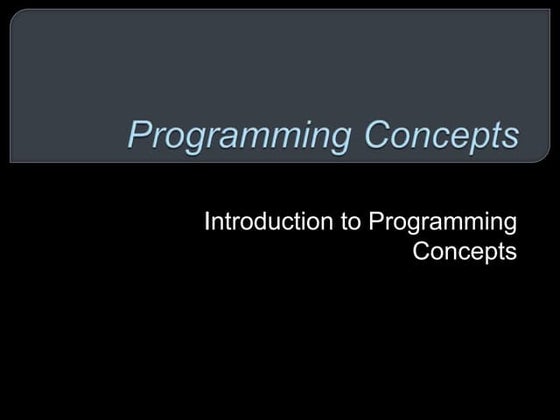



Basic programming conceptssalmankhan570
?
This document discusses the evolution of programming languages from early machine languages to modern higher-level languages. It begins with an introduction to human and computer languages. It then covers the development of machine languages, assembly languages, and higher-level languages like FORTRAN and COBOL. The document discusses the advantages of each generation of languages and examples of languages from the 1950s to modern times.Chapter 1



Chapter 1ZcelTablizo3
?
The document provides an overview of programming languages and the program development life cycle (PDLC). It discusses several types of programming languages including machine/assembly languages, algorithmic languages, business-oriented languages, education-oriented languages, and object-oriented languages. It also describes the six main steps of the PDLC: defining the problem, designing the program, coding the program, testing and debugging the program, documenting the program, and deploying and maintaining the program.Lesson 1-3 Fundamentals of Programming.pptx



Lesson 1-3 Fundamentals of Programming.pptxDysRobles
?
Here are the conversions:
11001 - Binary to Decimal = 49
165 - Decimal to Binary = 10100001
Decimal to Octal = 251
Decimal to Hexadecimal = A5
566 - Decimal to Binary = 111000010
Decimal to Octal = 1322
Decimal to Hexadecimal = 23A
1CC2 - Hexadecimal to Decimal = 7322
Hexadecimal to Binary = 00011100010010110
Hexadecimal to Octal = 4322Define Computer language, Translator, Standard input out C



Define Computer language, Translator, Standard input out CDr Shailendra Bhalawe
?
computer language and translatorIntroduction To Computer Programming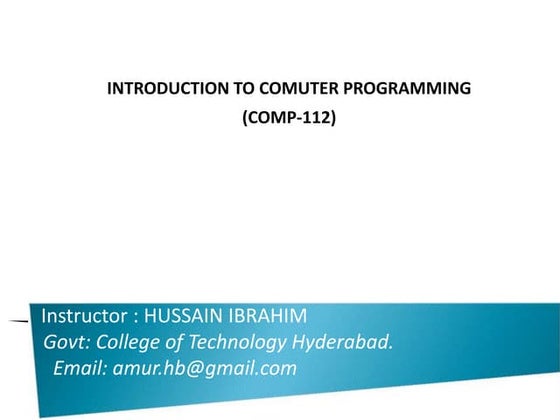



Introduction To Computer ProgrammingHussain Buksh
?
This document provides an introduction to computer programming concepts including:
- A programming language is a set of rules that allows communication between humans and computers to perform operations. Different languages have evolved for different types of programs and problem domains.
- Programs are written in high-level languages then compiled or interpreted into machine-readable code. Common language types include procedural, object-oriented, functional, and declarative languages.
- The programming process involves understanding the problem, designing an algorithm, writing source code, compiling for errors, debugging, and executing the program. Flowcharts can help design the program logic.Programming-Languages.pptx



Programming-Languages.pptxVrushabh Tokse
?
Programming Languages
Types of Programming Languages
Comparison of Programming Languages
Programming Language Trends
Future of Programming Languages
2 Programming Language.pdf



2 Programming Language.pdfKINGZzofYouTube
?
A programming language is a vocabulary and set of rules that instructs a computer to perform tasks. High-level languages like BASIC, C, Java, and Pascal are easier for humans than machine language but still need to be converted. Conversion can be done through compiling, which directly translates to machine language, or interpreting, which executes instructions without compilation. Popular languages today include Python, C, Java, and C++.Code learning



Code learningVikas kumar
?
Remember your first glance at a screenful of computer code? It probably felt like reading another language. Some words may have looked familiar, such as ¡°print¡± and ¡°input,¡± but they were surrounded by symbols and numbers that looked completely new.
https://codelearning4.wordpress.com/Introduction to high level Computer programming



Introduction to high level Computer programmingbilalchuddher
?
I have formulated three objectives that I hope this book will achieve for the reader.
These objectives are based on long experience teaching a course in multivariate
methods, consulting on multivariate problems with researchers in many fields, and
guiding statistics graduate students as they consulted with similar clients.
The first objective is to gain a thorough understanding of the details of various
multivariate techniques, their purposes, their assumptions, their limitations, and so
on. Many of these techniques are related; yet they differ in some essential ways. We
emphasize these similarities and differences.
The second objective is to be able to select one or more appropriate techniques for
a given multivariate data set. Recognizing the essential nature of a multivariate data
set is the first step in a meaningful analysis. We introduce basic types of multivariate
data in Section 1.4.
The third objective is to be able to interpret the results of a computer analysis
of a multivariate data set. Reading the manual for a particular program package is
not enough to make an intelligent appraisal of the output. Achievement of the first
objective and practice on data sets in the text should help achieve the third objective.
This chapter introduces the basic elements of matrix algebra used in the remainder
of this book. It is essentially a review of the requisite matrix tools and is not intended
to be a complete development. However, it is sufficiently self-contained so that those
with no previous exposure to the subject should need no other reference. Anyone
unfamiliar with matrix algebra should plan to work most of the problems entailing
numerical illustrations. It would also be helpful to explore some of the problems
involving general matrix manipulation.
With the exception of a few derivations that seemed instructive, most of the results
are given without proof. Some additional proofs are requested in the problems. For
the remaining proofs, see any general text on matrix theory or one of the specialized
matrix texts oriented to statistics, such as Graybill (1969), Searle (1982), or Harville
(1997) The transpose operation does not change a scalar, since it has only one row and
one column.
If the transpose operator is applied twice to any matrix, the result is the original
matrix: Informally, a random variable may be defined as a variable whose value depends on
the outcome of a chance experiment. Generally, we will consider only continuous
random variables. Some types of multivariate data are only approximations to this
ideal, such as test scores or a seven-point semantic differential (Likert) scale consisting of ordered responses ranging from strongly disagree to strongly agree. Special
techniques have been developed for such data, but in many cases, the usual methods
designed for continuous data work almost as well.a single observation y. The variance ¦Ò2 is defined shortly. The notation E(y)
indicates the mean of all possible values of y; that Programing paradigm & implementation



Programing paradigm & implementationBilal Maqbool ¥Ä
?
A programming language is a formal language used to describe computations. It consists of syntax, semantics, and tools like compilers or interpreters. Programming languages support different paradigms like procedural, functional, object-oriented, and logic-based approaches. Variables are named locations in memory that hold values and have properties like name, scope, type, and values.Foundry Analysis and sec lectire 01 .pdf



Foundry Analysis and sec lectire 01 .pdfmaanitech873
?
Nshsush bshsnsushe shehbshdhe sbhehs dhd dhe sye dhe dhe dhe dye hd eisne dhe dh edh edhe dhe sh bshe eyd ehd edbue eveIntroduction Programming Languages



Introduction Programming LanguagesManish Kharotia
?
Introduction to Programming Language(e.g. C & C++)
Get familiar to basic of programming languages... STARTING A CAREER IN PROGRAMMING



STARTING A CAREER IN PROGRAMMINGActonRoy
?
UNDERSTANDING COMPUTER PROGRAMMING
A programming language is used for instructing a computer to act according to the user¡¯s wish. It provides us with a medium of communication between humans and machine. Humans provide input and computer provides an output based on the input.
A computer is a hardware machine, and it can¡¯t interpret the human language to store and process data. It only uses binary language to understand commands.
https://lset.uk/Software



Softwaresoulkiller16
?
Application software includes general-purpose programs that perform common tasks and function-specific programs that support specific uses. Custom software is developed within an organization for its own use, while commercial off-the-shelf software is developed for broad, commercial sales. Widely used software suites bundle together productivity applications like word processing, spreadsheets, presentations, and databases into integrated packages.Programming language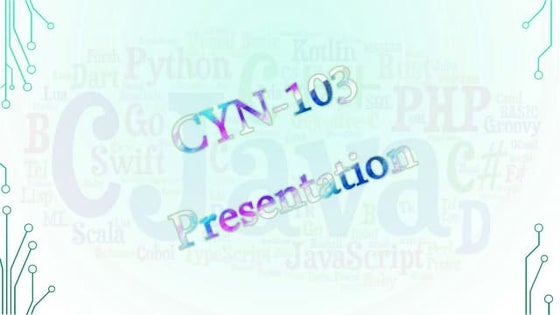



Programming languageMalayKalavadia
?
Information about the level of programming language, types of programming language, the principal paradigms, few programming languages, criteria for good language.Your Guide to be a Software Engineer



Your Guide to be a Software EngineerAhmed Mater
?
This document provides guidance on how to become a good software engineer. It discusses what programming is, different types of computer languages, popular programming majors, and how to learn software programming. The document recommends starting with online courses to learn programming basics and the integrated development environment. It also advises supplementing courses with books for a more comprehensive understanding and to develop an open mind. Community websites are recommended for discussions and problem solving help. The overall guidance is that both courses and books are important for learning, but courses are best to start as a beginner.English de lenguaje de programacion



English de lenguaje de programacionVillalba Griselda
?
This document discusses programming languages. It begins by asking what a programming language is and why there are so many types. It then defines a programming language as a set of rules that tells a computer what operations to perform. The document discusses the different types of programming languages like low-level languages close to machine code and high-level languages closer to English. It covers many popular programming languages from early generations like FORTRAN and COBOL to modern languages like C, C++, Java, and scripting languages. It concludes by discussing qualities of good programming languages like writability, readability, reliability and maintainability.GDSC career guide presentation.pptx



GDSC career guide presentation.pptxDishaSharma737984
?
? *Unlock Your Potential in the Tech World! Explore Your Career Path Today!* ?
Are you ready to dive into the exciting realm of technology and shape your career in cutting-edge domains? ??? Whether you're a budding enthusiast or an experienced professional, there's a world of opportunities waiting for you in the fields of Android & Web Development, AI/ML, Cybersecurity, Data Science, PR & Marketing, Designing, Programming Languages and Data Structures.
? *Android & Web Development*: Build the digital future by creating user-friendly apps and responsive websites.
? *AI/ML Enthusiasts*: Join the revolution of Artificial Intelligence and Machine Learning, making computers smarter and more capable of human-like tasks.
? *Cybersecurity Guardians*: Protect digital landscapes from evolving threats, safeguarding sensitive information and ensuring the integrity of systems.
? *Data Science Pioneers*: Dive into data-driven insights, unravel patterns, and make strategic decisions that shape industries and innovations.
? *PR & Marketing Maestros*: Craft compelling narratives, shape brand identities, and influence trends in the fast-paced world of tech communication.
? *Creative Designers*: Fuse technology with artistry; create visually stunning interfaces, logos, and graphics that leave a lasting impact.
? *Coding Champions*: Master programming languages and data structures to engineer solutions that solve real-world challenges.
? *Cloud Computing* Innovators: Harness the power of the cloud, revolutionize accessibility, and drive seamless digital transformation.
Embark on a journey of continuous learning and growth with resources such as online courses, workshops, webinars, and mentorship programs. Your passion, combined with the right knowledge, can lead to a fulfilling career in these dynamic domains. ?
Ready to take the next step?GDSC career guide presentation.pptx



GDSC career guide presentation.pptxAryanSharma853911
?
Presentation which was used in the Career Guide session organized by GDSC Guru Nanak Dev University, Regional Campus, Jalandhar hosted on 26 Aug 2023Smarter RAG Pipelines: Scaling Search with Milvus and Feast



Smarter RAG Pipelines: Scaling Search with Milvus and FeastZilliz
?
About this webinar
Learn how Milvus and Feast can be used together to scale vector search and easily declare views for retrieval using open source. We¡¯ll demonstrate how to integrate Milvus with Feast to build a customized RAG pipeline.
Topics Covered
- Leverage Feast for dynamic metadata and document storage and retrieval, ensuring that the correct data is always available at inference time
- Learn how to integrate Feast with Milvus to support vector-based retrieval in RAG systems
- Use Milvus for fast, high-dimensional similarity search, enhancing the retrieval phase of your RAG modelColumbia Weather Systems - Product Overview



Columbia Weather Systems - Product OverviewColumbia Weather Systems
?
Columbia Weather Systems offers professional weather stations in basically three configurations for industry and government agencies worldwide: Fixed-Base or Fixed-Mount Weather Stations, Portable Weather Stations, and Vehicle-Mounted Weather Stations.
Models include all-in-one sensor configurations as well as modular environmental monitoring systems. Real-time displays include hardware console, WeatherMaster? Software, and a Weather MicroServer? with industrial protocols, web and app monitoring options.
Innovative Weather Monitoring: Trusted by industry and government agencies worldwide. Professional, easy-to-use monitoring options. Customized sensor configurations. One-year warranty with personal technical support. Proven reliability, innovation, and brand recognition for over 45 years.More Related Content
Similar to Introduction-to-Computer-Languages.pptxx (20)
Lesson 1-3 Fundamentals of Programming.pptx



Lesson 1-3 Fundamentals of Programming.pptxDysRobles
?
Here are the conversions:
11001 - Binary to Decimal = 49
165 - Decimal to Binary = 10100001
Decimal to Octal = 251
Decimal to Hexadecimal = A5
566 - Decimal to Binary = 111000010
Decimal to Octal = 1322
Decimal to Hexadecimal = 23A
1CC2 - Hexadecimal to Decimal = 7322
Hexadecimal to Binary = 00011100010010110
Hexadecimal to Octal = 4322Define Computer language, Translator, Standard input out C



Define Computer language, Translator, Standard input out CDr Shailendra Bhalawe
?
computer language and translatorIntroduction To Computer Programming



Introduction To Computer ProgrammingHussain Buksh
?
This document provides an introduction to computer programming concepts including:
- A programming language is a set of rules that allows communication between humans and computers to perform operations. Different languages have evolved for different types of programs and problem domains.
- Programs are written in high-level languages then compiled or interpreted into machine-readable code. Common language types include procedural, object-oriented, functional, and declarative languages.
- The programming process involves understanding the problem, designing an algorithm, writing source code, compiling for errors, debugging, and executing the program. Flowcharts can help design the program logic.Programming-Languages.pptx



Programming-Languages.pptxVrushabh Tokse
?
Programming Languages
Types of Programming Languages
Comparison of Programming Languages
Programming Language Trends
Future of Programming Languages
2 Programming Language.pdf



2 Programming Language.pdfKINGZzofYouTube
?
A programming language is a vocabulary and set of rules that instructs a computer to perform tasks. High-level languages like BASIC, C, Java, and Pascal are easier for humans than machine language but still need to be converted. Conversion can be done through compiling, which directly translates to machine language, or interpreting, which executes instructions without compilation. Popular languages today include Python, C, Java, and C++.Code learning



Code learningVikas kumar
?
Remember your first glance at a screenful of computer code? It probably felt like reading another language. Some words may have looked familiar, such as ¡°print¡± and ¡°input,¡± but they were surrounded by symbols and numbers that looked completely new.
https://codelearning4.wordpress.com/Introduction to high level Computer programming



Introduction to high level Computer programmingbilalchuddher
?
I have formulated three objectives that I hope this book will achieve for the reader.
These objectives are based on long experience teaching a course in multivariate
methods, consulting on multivariate problems with researchers in many fields, and
guiding statistics graduate students as they consulted with similar clients.
The first objective is to gain a thorough understanding of the details of various
multivariate techniques, their purposes, their assumptions, their limitations, and so
on. Many of these techniques are related; yet they differ in some essential ways. We
emphasize these similarities and differences.
The second objective is to be able to select one or more appropriate techniques for
a given multivariate data set. Recognizing the essential nature of a multivariate data
set is the first step in a meaningful analysis. We introduce basic types of multivariate
data in Section 1.4.
The third objective is to be able to interpret the results of a computer analysis
of a multivariate data set. Reading the manual for a particular program package is
not enough to make an intelligent appraisal of the output. Achievement of the first
objective and practice on data sets in the text should help achieve the third objective.
This chapter introduces the basic elements of matrix algebra used in the remainder
of this book. It is essentially a review of the requisite matrix tools and is not intended
to be a complete development. However, it is sufficiently self-contained so that those
with no previous exposure to the subject should need no other reference. Anyone
unfamiliar with matrix algebra should plan to work most of the problems entailing
numerical illustrations. It would also be helpful to explore some of the problems
involving general matrix manipulation.
With the exception of a few derivations that seemed instructive, most of the results
are given without proof. Some additional proofs are requested in the problems. For
the remaining proofs, see any general text on matrix theory or one of the specialized
matrix texts oriented to statistics, such as Graybill (1969), Searle (1982), or Harville
(1997) The transpose operation does not change a scalar, since it has only one row and
one column.
If the transpose operator is applied twice to any matrix, the result is the original
matrix: Informally, a random variable may be defined as a variable whose value depends on
the outcome of a chance experiment. Generally, we will consider only continuous
random variables. Some types of multivariate data are only approximations to this
ideal, such as test scores or a seven-point semantic differential (Likert) scale consisting of ordered responses ranging from strongly disagree to strongly agree. Special
techniques have been developed for such data, but in many cases, the usual methods
designed for continuous data work almost as well.a single observation y. The variance ¦Ò2 is defined shortly. The notation E(y)
indicates the mean of all possible values of y; that Programing paradigm & implementation



Programing paradigm & implementationBilal Maqbool ¥Ä
?
A programming language is a formal language used to describe computations. It consists of syntax, semantics, and tools like compilers or interpreters. Programming languages support different paradigms like procedural, functional, object-oriented, and logic-based approaches. Variables are named locations in memory that hold values and have properties like name, scope, type, and values.Foundry Analysis and sec lectire 01 .pdf



Foundry Analysis and sec lectire 01 .pdfmaanitech873
?
Nshsush bshsnsushe shehbshdhe sbhehs dhd dhe sye dhe dhe dhe dye hd eisne dhe dh edh edhe dhe sh bshe eyd ehd edbue eveIntroduction Programming Languages



Introduction Programming LanguagesManish Kharotia
?
Introduction to Programming Language(e.g. C & C++)
Get familiar to basic of programming languages... STARTING A CAREER IN PROGRAMMING



STARTING A CAREER IN PROGRAMMINGActonRoy
?
UNDERSTANDING COMPUTER PROGRAMMING
A programming language is used for instructing a computer to act according to the user¡¯s wish. It provides us with a medium of communication between humans and machine. Humans provide input and computer provides an output based on the input.
A computer is a hardware machine, and it can¡¯t interpret the human language to store and process data. It only uses binary language to understand commands.
https://lset.uk/Software



Softwaresoulkiller16
?
Application software includes general-purpose programs that perform common tasks and function-specific programs that support specific uses. Custom software is developed within an organization for its own use, while commercial off-the-shelf software is developed for broad, commercial sales. Widely used software suites bundle together productivity applications like word processing, spreadsheets, presentations, and databases into integrated packages.Programming language



Programming languageMalayKalavadia
?
Information about the level of programming language, types of programming language, the principal paradigms, few programming languages, criteria for good language.Your Guide to be a Software Engineer



Your Guide to be a Software EngineerAhmed Mater
?
This document provides guidance on how to become a good software engineer. It discusses what programming is, different types of computer languages, popular programming majors, and how to learn software programming. The document recommends starting with online courses to learn programming basics and the integrated development environment. It also advises supplementing courses with books for a more comprehensive understanding and to develop an open mind. Community websites are recommended for discussions and problem solving help. The overall guidance is that both courses and books are important for learning, but courses are best to start as a beginner.English de lenguaje de programacion



English de lenguaje de programacionVillalba Griselda
?
This document discusses programming languages. It begins by asking what a programming language is and why there are so many types. It then defines a programming language as a set of rules that tells a computer what operations to perform. The document discusses the different types of programming languages like low-level languages close to machine code and high-level languages closer to English. It covers many popular programming languages from early generations like FORTRAN and COBOL to modern languages like C, C++, Java, and scripting languages. It concludes by discussing qualities of good programming languages like writability, readability, reliability and maintainability.GDSC career guide presentation.pptx



GDSC career guide presentation.pptxDishaSharma737984
?
? *Unlock Your Potential in the Tech World! Explore Your Career Path Today!* ?
Are you ready to dive into the exciting realm of technology and shape your career in cutting-edge domains? ??? Whether you're a budding enthusiast or an experienced professional, there's a world of opportunities waiting for you in the fields of Android & Web Development, AI/ML, Cybersecurity, Data Science, PR & Marketing, Designing, Programming Languages and Data Structures.
? *Android & Web Development*: Build the digital future by creating user-friendly apps and responsive websites.
? *AI/ML Enthusiasts*: Join the revolution of Artificial Intelligence and Machine Learning, making computers smarter and more capable of human-like tasks.
? *Cybersecurity Guardians*: Protect digital landscapes from evolving threats, safeguarding sensitive information and ensuring the integrity of systems.
? *Data Science Pioneers*: Dive into data-driven insights, unravel patterns, and make strategic decisions that shape industries and innovations.
? *PR & Marketing Maestros*: Craft compelling narratives, shape brand identities, and influence trends in the fast-paced world of tech communication.
? *Creative Designers*: Fuse technology with artistry; create visually stunning interfaces, logos, and graphics that leave a lasting impact.
? *Coding Champions*: Master programming languages and data structures to engineer solutions that solve real-world challenges.
? *Cloud Computing* Innovators: Harness the power of the cloud, revolutionize accessibility, and drive seamless digital transformation.
Embark on a journey of continuous learning and growth with resources such as online courses, workshops, webinars, and mentorship programs. Your passion, combined with the right knowledge, can lead to a fulfilling career in these dynamic domains. ?
Ready to take the next step?GDSC career guide presentation.pptx



GDSC career guide presentation.pptxAryanSharma853911
?
Presentation which was used in the Career Guide session organized by GDSC Guru Nanak Dev University, Regional Campus, Jalandhar hosted on 26 Aug 2023Recently uploaded (20)
Smarter RAG Pipelines: Scaling Search with Milvus and Feast



Smarter RAG Pipelines: Scaling Search with Milvus and FeastZilliz
?
About this webinar
Learn how Milvus and Feast can be used together to scale vector search and easily declare views for retrieval using open source. We¡¯ll demonstrate how to integrate Milvus with Feast to build a customized RAG pipeline.
Topics Covered
- Leverage Feast for dynamic metadata and document storage and retrieval, ensuring that the correct data is always available at inference time
- Learn how to integrate Feast with Milvus to support vector-based retrieval in RAG systems
- Use Milvus for fast, high-dimensional similarity search, enhancing the retrieval phase of your RAG modelColumbia Weather Systems - Product Overview



Columbia Weather Systems - Product OverviewColumbia Weather Systems
?
Columbia Weather Systems offers professional weather stations in basically three configurations for industry and government agencies worldwide: Fixed-Base or Fixed-Mount Weather Stations, Portable Weather Stations, and Vehicle-Mounted Weather Stations.
Models include all-in-one sensor configurations as well as modular environmental monitoring systems. Real-time displays include hardware console, WeatherMaster? Software, and a Weather MicroServer? with industrial protocols, web and app monitoring options.
Innovative Weather Monitoring: Trusted by industry and government agencies worldwide. Professional, easy-to-use monitoring options. Customized sensor configurations. One-year warranty with personal technical support. Proven reliability, innovation, and brand recognition for over 45 years.Sugarlab AI: How Much Does an XXX AI Porn Generator Cost in 2025



Sugarlab AI: How Much Does an XXX AI Porn Generator Cost in 2025Sugarlab AI
?
The cost of an XXX AI porn generator in 2025 varies depending on factors like AI sophistication, subscription plans, and additional expenses. Whether you're looking for a free AI porn video generator or a premium adult AI image generator, pricing ranges from basic tools to enterprise-level solutions. This article breaks down the costs, features, and what to expect from AI-driven adult content platforms.SAP Automation with UiPath: SAP Test Automation - Part 5 of 8



SAP Automation with UiPath: SAP Test Automation - Part 5 of 8DianaGray10
?
This interesting webinar will show how UiPath can change how SAP Test Automation works. It will also show the main benefits and best ways to use UiPath with SAP.
Topics to be covered:
Learn about SAP test automation and why it's important for testing.
UiPath Overview: Learn how UiPath can make your SAP testing easier and faster.
Test Manager: Learn about the key advantages of automating your SAP tests, including increased accuracy and reduced time.
Best Practices: Get practical tips on how to use and improve test automation with UiPath.
Real-World Examples: Demonstration on how organizations have successfully leveraged UiPath for SAP test automation.Getting the Best of TrueDEM ¨C April News & Updates



Getting the Best of TrueDEM ¨C April News & Updatespanagenda
?
Webinar Recording: https://www.panagenda.com/webinars/getting-the-best-of-truedem-april-news-updates/
Boost your Microsoft 365 experience with OfficeExpert TrueDEM! Join the April webinar for a deep dive into recent and upcoming features and functionalities of OfficeExpert TrueDEM. We¡¯ll showcase what¡¯s new and use practical application examples and real-life scenarios, to demonstrate how to leverage TrueDEM to optimize your M365 environment, troubleshoot issues, improve user satisfaction and productivity, and ultimately make data-driven business decisions.
These sessions will be led by our team of product management and consultants, who interact with customers daily and possess in-depth product knowledge, providing valuable insights and expert guidance.
What you¡¯ll take away
- Updates & info about the latest and upcoming features of TrueDEM
- Practical and realistic applications & examples for troubelshooting or improving your Microsoft Teams & M365 environment
- Use cases and examples of how our customers use TrueDEM202408_JAWSPANKRATION_Introduction_of_Minaden.pdf



202408_JAWSPANKRATION_Introduction_of_Minaden.pdfNTTDOCOMO-ServiceInnovation
?
202408³å´³´¡°Â³§±Ê´¡±·°¸é´¡°Õ±õ°¿±·³å×îÖÕ°æ.±è»å´ÚSTARLINK-JIO-AIRTEL Security issues to Ponder



STARLINK-JIO-AIRTEL Security issues to Ponderanupriti
?
A news clip from India's number 1 news paper HINDI....in which views shared on JIO-AIRTEL-Starlink security issuesLeadership Spectrum by Sonam Sherpa at GDG Kathmandu March Monthly Meetup



Leadership Spectrum by Sonam Sherpa at GDG Kathmandu March Monthly MeetupGDG Kathmandu
?
Leadership by Sonam SherpaFast Screen Recorder v2.1.0.11 Crack Updated [April-2025]![Fast Screen Recorder v2.1.0.11 Crack Updated [April-2025]](https://cdn.slidesharecdn.com/ss_thumbnails/dataanalysisforbusiness-250322061148-eeff8a831-250401123246-f36be9ca-250401141614-87b01766-thumbnail.jpg?width=560&fit=bounds)
![Fast Screen Recorder v2.1.0.11 Crack Updated [April-2025]](https://cdn.slidesharecdn.com/ss_thumbnails/dataanalysisforbusiness-250322061148-eeff8a831-250401123246-f36be9ca-250401141614-87b01766-thumbnail.jpg?width=560&fit=bounds)
![Fast Screen Recorder v2.1.0.11 Crack Updated [April-2025]](https://cdn.slidesharecdn.com/ss_thumbnails/dataanalysisforbusiness-250322061148-eeff8a831-250401123246-f36be9ca-250401141614-87b01766-thumbnail.jpg?width=560&fit=bounds)
![Fast Screen Recorder v2.1.0.11 Crack Updated [April-2025]](https://cdn.slidesharecdn.com/ss_thumbnails/dataanalysisforbusiness-250322061148-eeff8a831-250401123246-f36be9ca-250401141614-87b01766-thumbnail.jpg?width=560&fit=bounds)
Fast Screen Recorder v2.1.0.11 Crack Updated [April-2025]jackalen173
?
Copy This Link and paste in new tab & get Crack File
¡ı
https://hamzapc.com/ddl
Fast Screen Recorder is an incredibly useful app that will let you record your screen and save a video of everything that happens on it.
San Francisco Atlassian ACE - Mar 27 2025.pdf



San Francisco Atlassian ACE - Mar 27 2025.pdfMatt Doar
?
ºİºİߣs from 7 vendors at. the Atlassian ACE event in SF on March 27th 2025Research Data Management (RDM): the management of dat in the research process



Research Data Management (RDM): the management of dat in the research processHeilaPienaar
?
Presented as part of the M.IT degree at the Department of Information Science, University of Pretoria, South Africa. Module: Data management. 2023, 2024.Dragino¥×¥í¥À¥¯¥È¥«¥¿¥í¥° LoRaWAN NB-IoT LTE cat.M1ÉÌÆ·¥ê¥¹¥È



Dragino¥×¥í¥À¥¯¥È¥«¥¿¥í¥° LoRaWAN NB-IoT LTE cat.M1ÉÌÆ·¥ê¥¹¥ÈCRI Japan, Inc.
?
Dragino¥×¥í¥À¥¯¥È¥«¥¿¥í¥° LoRaWAN NB-IoT LTE cat.M1ÉÌÆ·¥ê¥¹¥ÈNetwork_Packet_Brokers_Presentation.pptx



Network_Packet_Brokers_Presentation.pptxKhushi Communications
?
Most people might think of a water faucet or even the tap on a keg of beer. But in the world of networking, "TAP" stands for "Traffic Access Point" or "Test Access Point." It's not a beverage or a sink fixture, but rather a crucial tool for network monitoring and testing. Khushi Communications is a top vendor in India, providing world-class Network TAP solutions. With their expertise, they help businesses monitor, analyze, and secure their networks efficiently.GDG Cloud Southlake #41: Shay Levi: Beyond the Hype:How Enterprises Are Using AI



GDG Cloud Southlake #41: Shay Levi: Beyond the Hype:How Enterprises Are Using AIJames Anderson
?
Beyond the Hype: How Enterprises Are Actually Using AI
Webinar Abstract:
AI promises to revolutionize enterprises - but what¡¯s actually working in the real world? In this session, we cut through the noise and share practical, real-world AI implementations that deliver results. Learn how leading enterprises are solving their most complex AI challenges in hours, not months, while keeping full control over security, compliance, and integrations. We¡¯ll break down key lessons, highlight recent use cases, and show how Unframe¡¯s Turnkey Enterprise AI Platform is making AI adoption fast, scalable, and risk-free.
Join the session to get actionable insights on enterprise AI - without the fluff.
Bio:
Shay Levi is the Co-Founder and CEO of Unframe, a company redefining enterprise AI with scalable, secure solutions. Previously, he co-founded Noname Security and led the company to its $500M acquisition by Akamai in just four years. A proven innovator in cybersecurity and technology, he specializes in building transformative solutions.Next.js Development: The Ultimate Solution for High-Performance Web Apps



Next.js Development: The Ultimate Solution for High-Performance Web Appsrwinfotech31
?
The key benefits of Next.js development, including blazing-fast performance, enhanced SEO, seamless API and database integration, scalability, and expert support. It showcases how Next.js leverages Server-Side Rendering (SSR), Static Site Generation (SSG), and other advanced technologies to optimize web applications. RW Infotech offers custom solutions, migration services, and 24/7 expert support for seamless Next.js operations. Explore more :- https://www.rwit.io/technologies/next-js
Testing Tools for Accessibility Enhancement Part II.pptx



Testing Tools for Accessibility Enhancement Part II.pptxJulia Undeutsch
?
Automatic Testing Tools will help you get a first understanding of the accessibility of your website or web application. If you are new to accessibility, it will also help you learn more about the topic and the different issues that are occurring on the web when code is not properly written.Solana Developer Hiring for Enterprises Key Considerations.pdf



Solana Developer Hiring for Enterprises Key Considerations.pdfLisa ward
?
Key considerations for hiring Solana developers in enterprises include expertise in Rust, smart contracts, Solana SDKs, security, and scalability.
All-Data, Any-AI Integration: FME & Amazon Bedrock in the Real-World



All-Data, Any-AI Integration: FME & Amazon Bedrock in the Real-WorldSafe Software
?
Join us for an exclusive webinar featuring special guest speakers from Amazon, Amberside Energy, and Avineon-Tensing as we explore the power of Amazon Bedrock and FME in AI-driven geospatial workflows.
Discover how Avineon-Tensing is using AWS Bedrock to support Amberside Energy in automating image classification and streamlining site reporting. By integrating Bedrock¡¯s generative AI capabilities with FME, image processing and categorization become faster and more efficient, ensuring accurate and organized filing of site imagery. Learn how this approach reduces manual effort, standardizes reporting, and leverages AWS¡¯s secure AI tooling to optimize their workflows.
If you¡¯re looking to enhance geospatial workflows with AI, automate image processing, or simply explore the potential of FME and Bedrock, this webinar is for you!Introduction-to-Computer-Languages.pptxx
- 1. Group members name : Vishal tiwari Krish jaiswal Tushar babariya Manthan dhanawade Roll No: 52458 52424 52402 52414 Class: FYBAF
- 2. Introduction to Computer Languages Computer languages are the building blocks for our digital world. They allow us to communicate with computers, enabling us to create software, applications, and websites. VT by Vishal Tiwari
- 3. History of Computer Languages The earliest computers used machine language, a series of 0s and 1s. Later, assembly language was developed, offering more human-readable instructions. 1 1940s Machine language 2 1950s Assembly language 3 1960s High-level languages, such as FORTRAN and COBOL, emerge. 4 1970s Structured programming and object-oriented programming paradigms gain traction. 5 Present Day Modern languages like Python, Java, and JavaScript are widely used in various fields.
- 4. Types of Computer Languages Computer languages can be categorized into several types based on their purpose and level of abstraction. 1 Scripting Languages Designed for automating tasks, such as web development and data processing. 2 Markup Languages Used to structure and format documents, such as HTML and XML. 3 Data Definition Languages Define the structure of databases and data types. 4 Query Languages Used to retrieve and manipulate data from databases, like SQL.
- 5. High-Level vs. Low-Level Languages High-level languages are more human-readable and easier to use, while low-level languages are closer to the machine's instructions. High-Level Closer to human language. Easy to learn and understand. Widely used for general-purpose programming. Low-Level Closer to machine language. Difficult to read and write. Used for specific tasks, such as system programming and embedded systems.
- 6. Compiled vs. Interpreted Languages Compiled languages are translated into machine code before execution, while interpreted languages are executed line by line. Compiled Languages Translated into machine code. Interpreter Executes code line by line. Machine Code Executable by the computer.
- 7. Syntax and Structure of Computer Languages Computer languages have specific rules governing their syntax and structure, like grammar and punctuation in human languages. Keywords Reserved words with specific meanings. Operators Symbols that perform operations on data. Data Types Specify the type of data, such as integers, strings, or booleans. Variables Named containers for storing data.
- 8. Common Programming Paradigms Programming paradigms provide a framework for structuring and organizing code. Paradigm Description Procedural Code is organized as a sequence of steps. Object-Oriented Code is organized around objects, which have data and methods. Functional Code is expressed as a series of functions. Logic Code is based on logical rules and predicates.
- 9. The Future of Computer Languages Computer languages continue to evolve, with new languages and paradigms emerging to address the challenges of the digital age. Artificial Intelligence AI-powered languages and frameworks are likely to play a significant role in the future. Quantum Computing Quantum computing will require new languages optimized for handling quantum operations. Blockchain Blockchain technology will continue to drive the development of languages for secure and decentralized applications.

